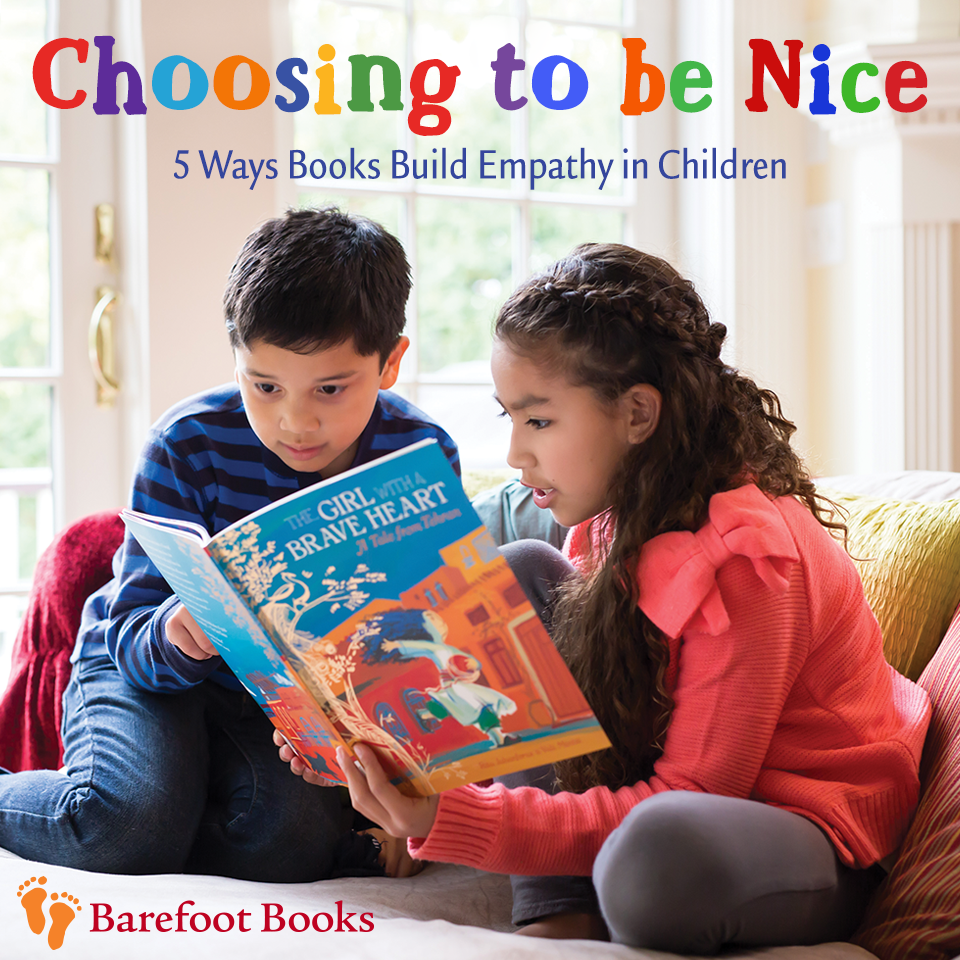 What’s your perspective on nice? We want to share. This is your column to offer your views. We welcome contributions.
What’s your perspective on nice? We want to share. This is your column to offer your views. We welcome contributions.
 Our guest post this week is from Stefanie Paige Wieder, M.S.Ed, Senior Director of Product at Barefoot Books and a child development expert with over 20 years of experience working with children and families and developing children’s products.
Our guest post this week is from Stefanie Paige Wieder, M.S.Ed, Senior Director of Product at Barefoot Books and a child development expert with over 20 years of experience working with children and families and developing children’s products.
Being kind to others – or unkind to others – is a choice we all make many times each day. Children frequently experiment with the effects of choosing to be nice, and not nice: If I hug my friend when she’s sad, what will happen? If I take my brother’s toy away, what will happen?
They also look to us for information and guidance. They notice if we yell at the guy who accidentally spilled our coffee; if we are understanding when someone makes a mistake; if we approve of a character in a book or movie who makes an unkind choice. Our actions, our reactions, and the media we allow our children to consume all influence their ability to empathize, which is at the heart of choosing to be nice.
By selecting books that help kids develop empathy, we equip them to choose to be nice more often than not. Look for books that…
- Allow kids to live vicariously. Books that feature relatable characters navigating emotions and social situations are a fantastic way to help children reflect on their own feelings and experiences with others. They provide a safe way for kids to see what happens when characters experiment with choosing to be nice and not nice.
Try reading: Herb, the Vegetarian Dragon United States/Canada
 In the hilarious picture book, Herb the Vegetarian Dragon, Herb must defend his vegetarian lifestyle to the bullying dragon, Meathook, who insists that, as a dragon, Herb must eat meat. Herb stands up for his principles, landing him in the kingdom’s dungeon. In the end, a young girl saves Herb by bravely standing up for him…and Meathook and his gang decide it’s better to be nice than to keep fighting.
In the hilarious picture book, Herb the Vegetarian Dragon, Herb must defend his vegetarian lifestyle to the bullying dragon, Meathook, who insists that, as a dragon, Herb must eat meat. Herb stands up for his principles, landing him in the kingdom’s dungeon. In the end, a young girl saves Herb by bravely standing up for him…and Meathook and his gang decide it’s better to be nice than to keep fighting.
- Remind young ones there’s no “I” in “team”. Showing children that there are scenarios in which everyone can “win” by working together helps them think outside the box and make kind choices. Books that model collaborative problem solving encourage kids to recognize that there don’t necessarily need to be winners and losers.
 Try reading: The Gigantic Turnip United States/Canada
Try reading: The Gigantic Turnip United States/Canada
- Celebrate diversity. Research shows that children begin to develop harmful stereotypes by the young age of two! Stories that respectfully depict diverse characters can open the door to conversations about how we are similar and different, breaking down stereotypes and deepening children’s ability to empathize. Diverse and inclusive books can go a long way towards creating an environment of kindness.
 Try reading: The Barefoot Book of Children United States/Canada
Try reading: The Barefoot Book of Children United States/Canada
The Barefoot Book of Children is a ground-breaking celebration of children from all over the world. Its beauty is that it depicts children as individuals, rather than as members of homogeneous cultures. So as children learn about customs from around the world, they are also learning that each person is special and unique.
- Cultivate gratitude. There’s a relationship between gratitude and well-being; among other benefits, practicing gratitude can increase our compassion. Books that depict the power of gratitude can prompt children to be thankful, which in turn will boost their powers of empathy.
 Try reading: The Blue Bird’s Palace United States/Canda
Try reading: The Blue Bird’s Palace United States/Canda
When we meet Natasha, the main character in The Blue Bird’s Palace, she is definitely making the choice to not be nice. And her choice has serious consequences: the Guardian of the Blue Forest transforms her into a blue bird and locks her away in a palace! Her palace is everything she thought she ever wanted, but Natasha begins to miss her widowed, lonely father, back home on the orchard. Will she learn to be grateful for what she has, or will she remain a blue bird forever?
- Model kindness. As we all know, it’s not always easy to choose to be nice. Books that show a character choosing kindness in challenging circumstances show children that kindness is possible even in the face of adversity.
 Try Reading: The Girl with the Brave Heart United States/Canada
Try Reading: The Girl with the Brave Heart United States/Canada
Young Shiraz lives a lonely life with her stepmother and stepsister, completely unaware of the old woman who lives alone next door…until Shiraz’s runaway yarn ball brings them face-to-face. Despite the old woman treating her rudely, Shiraz responds again and again with understanding and kindness until they develop a life-changing friendship. This beautiful story from Tehran-born Israeli pop star Rita Jahanforuz explores the power of listening to others and the value of empathy.
Story time can be powerful! The next time you select books for the children in your life, consider stories that boost empathy, and, in turn, help children choose to be nice.
For more of my tips, activities, and book recommendations, join the FREE Barefoot Books Summer Reading Club!


